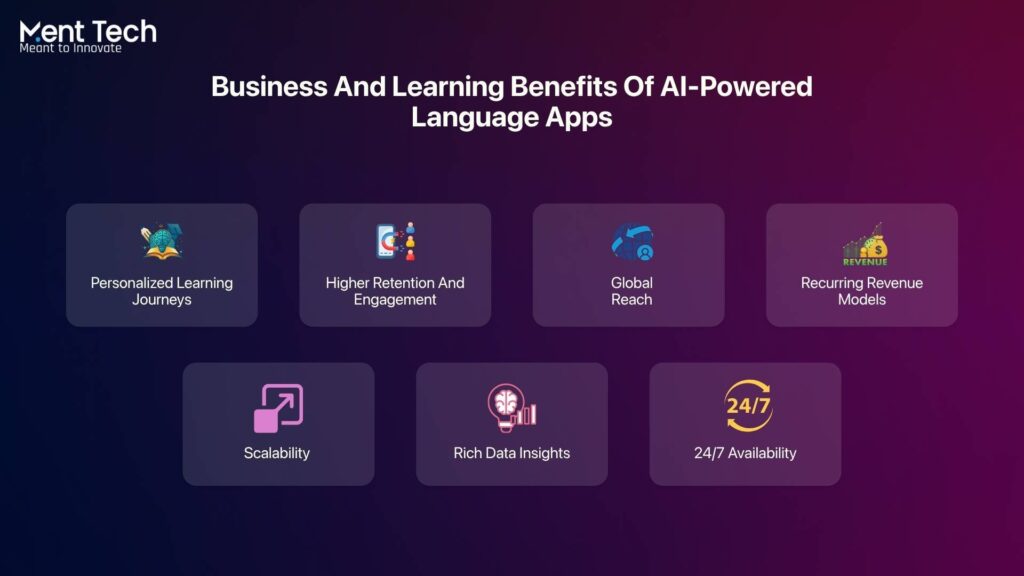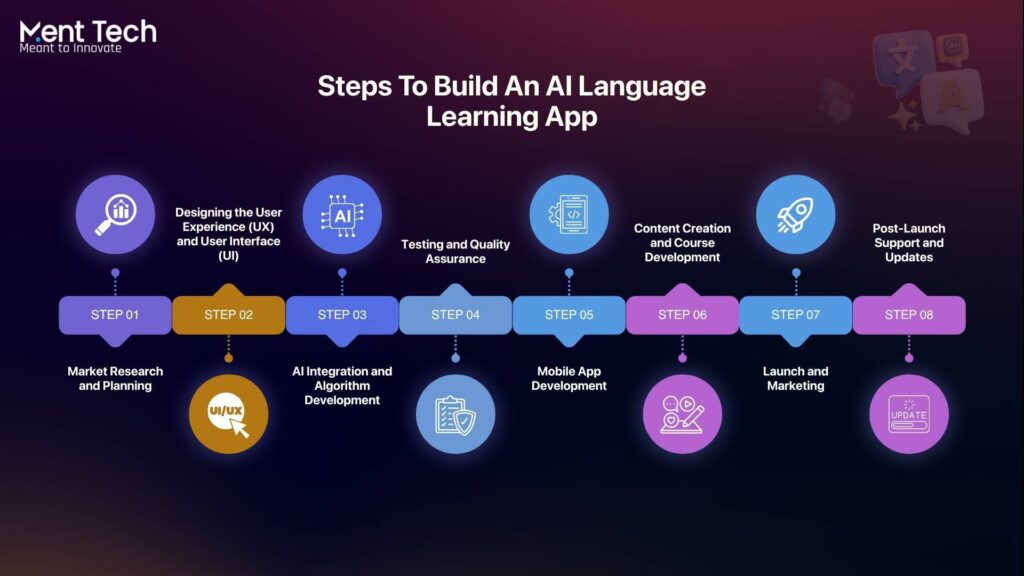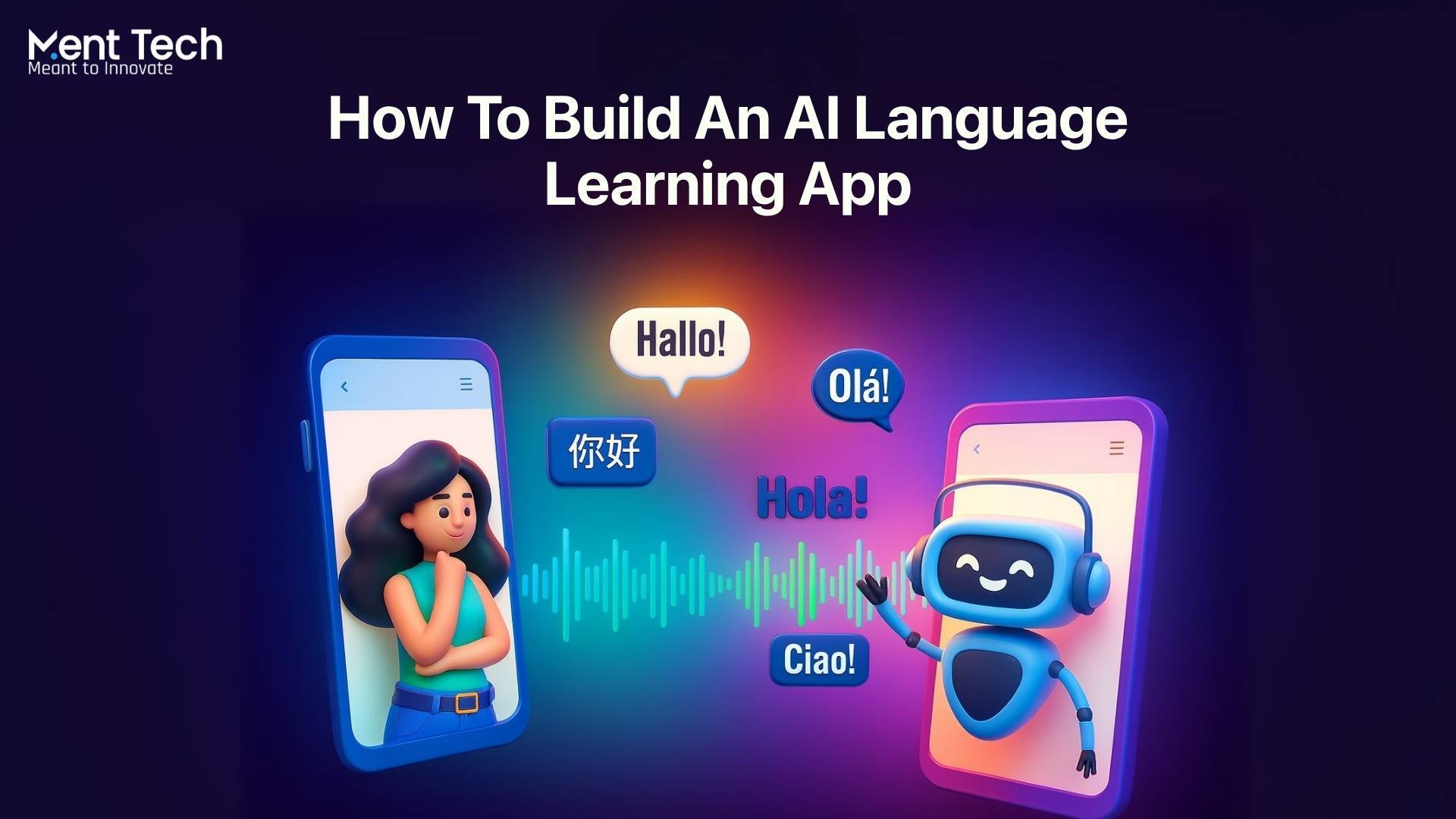AI is not a side show in classrooms anymore. It is how millions of learners already study, write, speak, and get feedback every single day. Global surveys through 2024–2025 show a clear shift: roughly eight in ten students use AI for schoolwork, and a large share use it weekly or even daily. That is not a future trend. That is the baseline your product will meet on day one.
Governments are moving too. Kazakhstan just approved a national framework for AI in education that covers schools, colleges, and vocational programs. It sets standards for ethics, academic integrity, privacy, and teacher training, and it does it with a clear implementation roadmap rather than slogans. The joint order came from the education ministry and the digital development ministry, and it leans on guidance from UNESCO, the EU, and the OECD. The message is simple. Use AI, but use it responsibly. Build skills, not shortcuts.
This is the backdrop for an ai language learning app in 2025. Learners expect instant feedback, real speaking practice, and personal pacing that fits a busy life. Institutions expect transparency, data protection, and tools that support teachers rather than replace them. If you can deliver both the learner experience and the governance story, you are not just shipping another app. You are building infrastructure for how people will learn to speak, write, and think in new languages.
What Is An AI-Based Language Learning App?
An AI-based language learning app is a smart tutor that adapts to every learner instead of following a rigid script. It studies how a person learns, tracks progress, and then shapes lessons around their needs. With this approach, practice feels personal and meaningful rather than repetitive.
An ai powered language learning app can listen to your speech, point out pronunciation mistakes, correct grammar, and even suggest more natural ways to phrase a sentence. It uses technologies like speech recognition, natural language processing, and machine learning to deliver real-time feedback. The more you use it, the better it understands your strengths and weaknesses, and the more effective your learning becomes.
Unlike older study tools that only focus on memorizing words, these apps simulate real conversations. You can role play ordering food in Spanish, making small talk in French, or practicing business English for meetings. This is why the best ai for language learning is not just about building vocabulary but about creating confidence to use a language in everyday life.

Today’s learners want flexibility, and ai language learning apps make that possible. Lessons can be done at home, on the move, or between tasks. Progress is stored across devices, and learners can return at any time without losing momentum. In short, an AI-based language learning app becomes a teacher, a speaking partner, and a study guide combined into one accessible platform.
Top 5 AI Language Learning Apps In 2025

If you are thinking about building an ai language learning app, it helps to look at the leaders already shaping the space. These platforms show how AI can personalize practice, motivate learners, and make language study part of daily life. Here are the top AI language learning apps to watch in 2025.
1. Duolingo
Duolingo remains one of the most popular ai language learning apps in the world, with tens of millions of people practicing daily. The app uses its AI system BirdBrain to personalize lessons by predicting how a learner will perform and then adjusting the difficulty level accordingly. This ensures that each exercise feels achievable while still challenging enough to promote growth.
Its short, game-like sessions make learning fun and easy to fit into busy schedules. Users can practice reading, writing, listening, and speaking while tracking progress through streaks and rewards. Duolingo shows why it is consistently ranked as one of the best ai apps for language learning in 2025.
2. Babbel
Babbel focuses on helping learners improve practical vocabulary and conversational skills. Its AI continuously monitors performance and tailors lessons to match the user’s needs. For example, if someone is strong in vocabulary but struggles with grammar, the app automatically shifts more attention to grammar-focused exercises.
The platform combines audio, text, and real-life examples to make the learning experience natural and relevant. With AI guiding the flow of lessons, Babbel is widely seen as one of the most effective ai powered language learning apps for learners of all ages.
3. Memrise
Memrise has built its reputation on helping people remember new words, and its AI takes that mission to another level. Some platforms even go beyond casual practice and act like an Academic Tutoring Assistant, guiding learners with structured lessons and real-time support.
It also enriches the experience with text-to-speech features and authentic video clips of native speakers. This combination makes Memrise not just a vocabulary trainer but one of the best AI for language learning when it comes to recall and real-world usage.
4. Busuu
Busuu combines the power of AI with human interaction, giving learners both personalization and community. Its Vocabulary Trainer adapts to user performance by recommending words and exercises based on learning history. This helps learners stay consistent and improve steadily over time.
An AI language coach built into the app can give learners 24/7 practice, instant feedback, and support that feels personal. Busuu positions itself as one of the most trusted ai language learning apps worldwide.
5. Rosetta Stone
Rosetta Stone has been a leader in language education for decades, and its adoption of AI has kept it competitive in 2025. The platform creates immersive experiences by simulating real-world scenarios, which helps learners apply language in context. Its AI-driven speech recognition also provides detailed feedback on pronunciation.
Learners can practice speaking, listening, reading, and writing in a structured yet adaptive environment. This mix of immersive content and AI guidance makes Rosetta Stone a relevant and powerful choice among top ai language learning apps today.

Key Features Of A Successful AI Language Learning App
1. Personalized Onboarding
The first minutes inside an ai language learning app decide if a learner will stay or leave. Smart onboarding should ask about goals, current fluency, and time commitment, then build a learning path that feels custom-made. AI can even run a short diagnostic quiz to recommend the perfect starting point.
This type of tailored introduction gives users an immediate sense of progress. Instead of being dropped into generic lessons, they feel guided, supported, and motivated from the start.
2. Smart Lesson Modules
A modern app goes beyond flashcards. Lesson modules need to combine text, audio, and visuals so learners can practice in multiple ways. Through multimodal AI development, lessons can combine text, voice, and images to create a richer, more immersive learning experience.”
This balance makes the experience engaging and productive. It feels less like homework and more like interactive coaching, which is why people keep coming back.
3. Real-Time Speech Recognition
Speaking is often the hardest part of learning a new language. By using AI-driven speech recognition, an app can analyze pronunciation down to syllables and pacing. This creates instant, specific feedback that helps learners build confidence without waiting for a teacher.
When a learner hears corrections right after speaking, they can adjust immediately. This turns practice into a natural loop that accelerates fluency.
4. NLP Grammar Correction
With the right tools and guidance from Natural Language Processing experts, your app can deliver precise grammar correction and context-aware feedback. Instead of just marking something wrong, it becomes a teaching moment.
This type of feedback is what makes the best AI for language learning stand out. Learners gain a deeper understanding of sentence structure and build long-term skills.
5. Adaptive Learning Paths
Every learner progresses differently. Adaptive paths let the app raise or lower difficulty depending on performance. If someone struggles, the app slows down and reinforces the basics. If they excel, it introduces new challenges faster.
This ensures learners always feel stretched but never overwhelmed. It is the digital version of having a personal tutor that senses your progress and adjusts accordingly.
6. Spaced Repetition
Remembering vocabulary takes more than practice; it takes timing. Spaced repetition engines surface words just when a learner is about to forget them, strengthening long-term memory.
An ai powered language learning app that integrates this system helps learners master thousands of words efficiently, turning passive memorization into active recall.
7. AI Chat Language Learning Tools
One of the biggest breakthroughs is the ability to practice real conversations with AI. These ai chat language learning tools can simulate ordering food, making small talk, or even preparing for a job interview.
Conversational AI and chatbot development are key here, enabling 24/7 practice with virtual partners that feel natural and engaging. The app then provides corrections on grammar, tone, and phrasing, acting as a true ai language speaking partner.
8. Gamification That Drives Motivation
Gamification works when it feels meaningful. Daily streaks, point systems, and unlockable achievements can turn practice into a habit. The key is to make the rewards tie back to real progress, not just cosmetic badges.
When designed thoughtfully, gamification keeps motivation high during the tough parts of learning. It encourages consistency, which is the single most important factor in mastering a new language.
9. Progress Tracking
Learners want to see proof that they are improving. A strong progress dashboard shows fluency percentages, highlights weak areas, and predicts future performance.
This data-driven view gives learners ownership of their journey. It reinforces commitment and makes them more likely to continue long-term.
10. Offline Sync Across Devices
Flexibility matters. An ai language learning app should let users download lessons for offline practice and then sync progress across phone, tablet, or computer.
This makes learning accessible anytime, whether on a train, in a café, or during a flight. Convenience builds habit, and habit builds fluency.
Key Benefits Of AI Language Learning App Development

When you build an AI language learning app, you are not just creating another digital tool. You are offering a smarter way to learn that directly responds to what modern users want: flexibility, personalization, and results. For founders, investors, and educators, these apps open up new business opportunities while also improving the learning experience. Many businesses also turn to AI consulting services to refine their strategy and identify the most effective way to integrate intelligent features into language learning apps.
Let’s break down the key benefits that make AI-powered language learning apps so effective.
1. Personalized Learning Journeys
Traditional courses treat every learner the same, but AI changes that. With adaptive paths, the app can identify where someone struggles and adjust lessons in real time. A beginner and an advanced learner can both use the same platform and still feel like it was built just for them. This level of personalization boosts learner confidence and keeps them moving forward at their own pace.
2. Higher Retention And Engagement
Learning a language is a long journey, and most people give up too soon. AI language learning apps use gamification, instant feedback, and conversational practice to make lessons feel more like play than study. AI platforms for business growth & higher ROI are redefining how companies build and scale educational products, making language learning apps a profitable venture.
3. Global Reach
Unlike local classes, a language learning app can serve users across the world. With AI support for multiple languages, the same app can help someone in Europe learn Mandarin while a student in Asia learns Spanish. This ability to scale across regions makes AI-powered apps a powerful way to tap into global demand.
4. Recurring Revenue Models
From a business perspective, the monetization opportunities are strong. Subscriptions, in-app purchases, and premium features like AI chat partners or advanced grammar tools create steady revenue streams. Unlike one-time course fees, these models allow companies to build predictable income while continuously improving the product.
5. Scalability
Once the foundation of the app is in place, scaling becomes easier. You can add new languages, new levels of difficulty, or even specialized learning tracks without having to rebuild the system from scratch. This flexibility is what makes AI-powered apps sustainable for long-term growth.
6. Rich Data Insights
Every interaction on the app creates valuable data about how people learn, where they struggle, and what keeps them engaged. These insights can help refine lessons, improve features, and even guide the creation of new products. For businesses, this data becomes a competitive advantage in shaping future offerings.
7. 24/7 Availability
Human tutors are limited by time zones and availability, but an AI-powered app never sleeps. Learners can practice in the middle of the night, on a commute, or during lunch breaks. This constant availability makes language learning more accessible and ensures that practice can fit into anyone’s daily routine.
How AI Language Learning Apps Work?
An ai language learning app may look simple on the surface, but behind every exercise and conversation there is a set of smart technologies working together. These tools make the app feel personal, responsive, and effective for every learner. Behind the scenes, strong machine learning development allows the app to adapt based on learner progress and continuously refine its recommendations.
1. Natural Language Processing (NLP)
NLP helps the app understand text input, spot grammar mistakes, and suggest corrections. When a learner writes a sentence, the app can highlight errors and explain why a different structure is better.
2. Large Language Models (LLMs)
LLMs power the conversations that make an app feel alive. They allow users to chat about everyday topics and receive natural, human-like responses. With advancements in LLM development, large language models can now generate realistic dialogues that simulate human conversation.
3. Speech Recognition
Speech recognition converts spoken words into text and analyzes pronunciation. It detects where a learner is struggling, whether it is with a sound, syllable, or tone, and then provides instant feedback.
4. Machine Learning
Machine learning studies how learners progress over time. It identifies patterns in strengths and weaknesses and adapts the difficulty of lessons. This creates personalized learning paths that keep users engaged without overwhelming them.
5. Spaced Repetition Engines
These engines are designed to help learners remember vocabulary. They bring back words at the exact time the learner is most likely to forget them, turning short-term knowledge into long-term recall.
6. Text-to-Speech (TTS)
TTS allows the app to pronounce words and phrases clearly. Learners can hear the correct accent, intonation, and rhythm, making it easier to imitate and practice real-world conversation.
7. Recommendation Systems
Recommendation systems act like guides inside the app. They suggest the next best lesson, extra practice exercises, or review sessions based on performance. This keeps the experience structured while still flexible.
Together, these technologies transform a simple app into an intelligent tutor. They allow ai chat language learning tools to feel interactive, supportive, and personal, which is what makes them so effective in 2025.
Steps To Build An AI Language Learning App

Building an ai language learning app takes more than just coding. It is a process that moves from research to design, development, and long-term support. Each step is important to make sure the app is not only functional but also engaging and scalable.
1. Market Research And Planning
The journey begins with understanding the audience. Who are the learners? What languages are in demand? What gaps exist in current apps? Market research shapes the roadmap and ensures the app solves real problems.
2. Designing The User Experience And Interface
An app is only as good as the way it feels in the learner’s hands. Clean navigation, attractive visuals, and simple lesson flows are critical. A strong design ensures users feel guided instead of overwhelmed.
3. AI Integration And Algorithm Development
This is where intelligence comes in. From NLP for grammar correction to speech recognition for pronunciation, AI algorithms give the app its smart, adaptive edge. Choosing the right models and APIs is key to success.
4. Content Creation And Course Development
No matter how advanced the AI, the app still needs solid content. Lessons, exercises, and cultural notes must be designed with accuracy and context in mind. AI can help scale content, but expert review keeps it authentic.
5. Mobile App Development
The core coding phase brings design and AI to life. Developers build cross-platform apps that run smoothly on iOS and Android, with fast load times and offline capabilities.
6. Testing And Quality Assurance
Before launch, every feature must be tested for performance, accuracy, and security. AI-driven apps are complex, so testing includes both technical and user-experience checks.
7. Launch And Marketing
A successful app launch is more than publishing in app stores. It requires marketing campaigns, app store optimization, and community outreach to attract early users and build momentum.
8. Post-Launch Support And Updates
The work continues after release. Regular updates, bug fixes, and new AI-driven features keep learners engaged. Ongoing support ensures the app grows with its user base.
Challenges In Building An AI Language Learning App
Creating an AI-powered language learning app sounds exciting, but it comes with its own set of hurdles. The technology is powerful, yet it is not without limitations. Understanding these challenges early helps you plan better and avoid costly mistakes during development.
- Handling Multiple Languages And Dialects: Different languages have unique grammar rules, idioms, and sentence structures. Add in regional accents and dialects, and the complexity grows. Building an app that can handle this variety without confusing learners is one of the toughest tasks. Developers need strong multilingual NLP models and careful fine-tuning to make it work well.
- Real-Time Speech Processing: Many users want instant feedback on their pronunciation and fluency. The problem is that real-time speech recognition can become clunky when the app lags or mishears words. To keep the experience smooth, the system must process audio quickly and accurately, even when learners practice in noisy environments.
- Scaling High-Quality Content: AI can support lesson creation, but it cannot replace human expertise when it comes to accuracy. Building large libraries of vocabulary, cultural notes, and interactive exercises requires time and often the help of native speakers. Without this effort, the app risks losing credibility with learners.
- Balancing Personalization Without Overload: AI is great at tailoring lessons, but too much personalization can overwhelm users. If learners constantly see changes in lesson flow or get too many nudges, they may feel confused instead of motivated. The challenge is finding a balance where the app adapts quietly in the background while keeping the interface simple.
- Privacy And Data Protection: An AI language learning app collects sensitive information, from voice samples to learning progress. Protecting this data is not optional. Regulations like GDPR and COPPA require strict compliance, especially if the app is used by students or minors. Security needs to be built into the foundation of the app, not added later.
- Managing Costs Of AI Integration: AI features like speech recognition and NLP require significant computing power. Running these models around the clock can become expensive, especially for startups. Finding the right mix of third-party APIs and in-house solutions is critical to keep budgets under control.
- Maintaining Learner Engagement Over Time: Getting users to download the app is easy. Keeping them motivated week after week is much harder. Without smart gamification, progress tracking, and interactive challenges, learners may drop off quickly. This makes engagement strategy just as important as technology.
Cost Of Building An AI Language Learning App
The cost of building an AI-based language learning app depends on the complexity of features, design quality, and the scale you want to achieve. A simple app with basic lessons and quizzes will naturally cost less than a full-fledged platform with real-time speech recognition, NLP grammar correction, gamification, and adaptive learning paths.
On average, development costs range between $100,000 and $330,000+. This includes everything from early planning and UI/UX design to backend development, AI integration, testing, and marketing. Essential features like speech recognition and AI-powered content personalization require specialized tools and add to the budget.
| Service Type | Estimated Cost ($) |
| Market research and planning | $5,000—$15,000 |
| Design (UI/UX) | $10,000—$30,000 |
| Backend development | $20,000—$50,000 |
| Frontend development | $15,000—$40,000 |
| Speech recognition integration | $10,000—$30,000 |
| AI tools integration | $15,000—$40,000 |
| Content creation | $10,000—$40,000+ |
| Testing | $5,000—$20,000 |
| Deployment | $2,000—$5,000 |
| Project management | $5,000—$15,000 |
| Marketing | $10,000—$30,000 |
| Ongoing maintenance and updates | $5,000—$20,000 per year |
| Total cost | $100,000—$330,000+ |
Partner With Ment Tech To Develop Your AI Language Learning App
Building an AI-powered language learning app takes more than just coding. It requires a thoughtful approach that blends advanced technology, engaging design, and a clear growth strategy. Working with the right AI development company is crucial in this situation. If you are looking to hire AI developer talent with proven expertise, our team at Ment Tech Labs is ready to support your vision.
At Ment Tech Labs, we understand what it takes to create apps that learners enjoy and businesses can scale. As an experienced AI development company, we help you at every step, from shaping the first idea to designing user-friendly experiences, integrating AI models, and ensuring smooth performance after launch. Our focus is on delivering products that combine personalization, real-time feedback, and long-term value.
If you are serious about launching a language learning app that stands out in 2025, our team is ready to make it happen. Partner with us to develop a platform that adapts to learners, reaches global markets, and grows with your vision.
FAQs
These apps use technologies like natural language processing, speech recognition, and machine learning to understand user input and adapt lessons in real time. They can evaluate pronunciation, correct grammar, and recommend personalized exercises.
Must-have features include personalized onboarding, smart lesson modules, real-time speech recognition, NLP-powered grammar correction, adaptive learning paths, spaced repetition, AI chat partners, gamification, progress tracking, and offline sync.
A minimum viable product (MVP) usually takes 12–16 weeks. A fully featured platform with advanced AI, gamification, and multiple languages can take 6 months or more.
AI apps are powerful for daily practice, instant feedback, and personalized learning, but they do not fully replace human tutors. The best approach is to combine AI-based practice with real-world conversations.
Yes, if the app follows data privacy standards like GDPR and COPPA. Parents should check if the app includes parental controls, secure data storage, and transparent privacy settings.
They offer personalized learning experiences, real-time corrections, 24/7 availability, global reach, scalable business models, and better retention through gamification and adaptive content.


